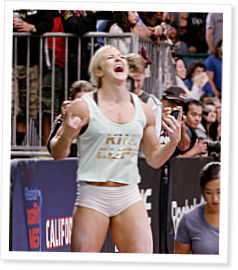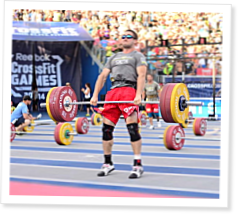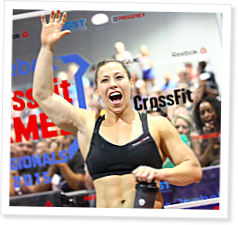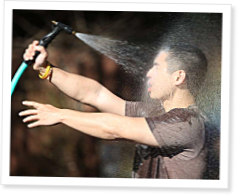The Starting Strength Weekly Report 2015-05-18: Topics from the Forums: “Some Thoughts on Meets and Goals” and “The VMO Thread - Patellar dislocation and quad strengthening” . This week Under the Bar: Strength & Health.
View report in browser
var addthis_config = {"data_track_addressbar":true};
News
Announcements
Submit your images to enter this month’s Under the Bar prize drawing.
Articles
“Starr Light, Starr Bright, Starr Gone”: Marty Gallagher writes on the enormous influence of Bill Starr.
Testimonial
EverStronger shares her dramatic progress: [I]t is week 46 of my training. 46 weeks since I could not perform a squat to depth. I am 30 years old, 5’5” and weigh 164 lbs. I squat 185 five by five, I deadlift double overhand 200 for five, press 70 five by five and bench 130 five for five. I have lost 46 pounds of fat.
SS Coaches’ Updates & Blogs
Tom Campitelli has posted the full results of the Oakland Strengthlifting Meet.
Under the Bar
Focus Personal Training Institute’s weekly barbell club where students and alumni alike lift and coach using the Starting Strength model. [photo courtesy of Brent J Carter]
Adam Watson (paterfamilias), 47, 225 lbs, at the Alaska State Powerlifting Championship on May 2, 2015. 1355.7 total. 1st place, M1b 105kg. 2nd place Open 105kg. Top, 485 lb squat; Bottom, 523.6 lb deadlift. [photos courtesy of Adam Watson]
High school senior, Chelsey, is ready to pull 175lbs x 5. She pulled 200lb x 2 soon after. Weighing 125lb, Chelsey has embraced becoming stronger to match up to Big Ten competitors on the soccer field next fall. [Photo courtesy of Brad Gudenkauf]
Top, Shannon finishes her power clean strong. Good rack position with the bar on the deltoids and her elbows held high. Bottom, Diego Socolinsky coaches Nikki on the power snatch. [photo courtesy of Emily Socolinsky, FiveX3 Training]
Right click images to enlarge.
Submit your images to report@startingstrength.com
Submission guidelines to enter the May Under the Bar prize drawing.
Best of the Week
Some Thoughts on Meets and Goals
OCG
As a general strength trainee, you should probably not do meets. Especially as an older trainee who doesn’t need the wear and tear and who just wants to be strong enough to keep the walker in the closet. However, if you want to keep progression going or take it further, it can be a very useful motivational tool. You have a meet on a set date and you have to show up and put up. It gives you a clear goal and a clear set of numbers. This can help with compliance and let you know exactly what numbers you have to hit and when. For such a trainee a meet should be basically working up to a 1RM in the three lifts. It is a good opportunity to see exactly how fast you have progressed. Meets done in this manner should be done sparingly, once, perhaps twice a year with good programming.
For the competitive powerlifter however, a meet is a different affair with different goals. You might do a meet to qualify for another meet. You might do a meet to get experience doing meets. But mostly, you go to a meet to win or place. With this goal in mind we can see that the approach is somewhat different. Namely, if you can achieve your goals without having to lift a 1RM, or even anything significantly heavy, you should do so. A younger or newer powerlifter might indeed have to be hitting a 1RM to win a meet more often than a more experienced and stronger competitor. However, such an effort may not represent an overly taxing effort or require a long recovery time, due to the lighter weights lifted. Further more, perhaps newer lifters should focus on gaining more experience with meets and how they react to such an environment. If this is the goal then winning takes a back seat. A heavy single should be lifted yes, but probably no more than 90 - 95%. Heavy enough to require effort, but not a true 1RM that would require significant recovery time and impact training.
A more advanced lifter who might be strong enough to win a meet without hitting a 1RM or has competitive goals of the kind that require qualifying meets should probably avoid hitting a 1RM as much as possible. A 1RM represents a significant amount of effort and recovery time at this level. If you need to put up a qualifying total, it should be as low as possible, just barely scraping in, so as to require the least amount of effort and the least amount of disruption to your training to get stronger. At this level of strength, a smaller regional meet might well be won without putting in 100% by a good lifter. If you can do so, there is no reason not to. Larger meets such as national meets might require 1RM attempts to even place, and given their importance they probably warrant such effort. Overall, a consideration of the goal of the meet and how it factors into a larger competitive career is important, and should not be lost sight of.
Best of the Forum
MinnesotaMike
Did some homework: The vastus medialis oblique (VMO) doesn’t actually exist, but instead is a—largely imagined—oblique aspect to the vastus medialis (VM) that was believed to have had a significant enough impact on patellar stabilization to warrant it’s own name. I’m guessing people believed that, since the vastus lateralis is what technically pulls the patella off track, compensating with VM work would restore some balance. But without the medial retiaculum providing the bulk of the opposing resistance, even a VM the size of a VW wouldn’t help much. And for the punch-line, since it doesn’t seem like the VM can be effectively isolated, all my quad work will just strengthen the vastus lateralis (VL) equivalently and result in no net change on the forces placed on my patella.
Jordan Feigenbaum
The nomenclature “VMO” came from Lieb and Perry’s publication in the JBJS in 1968 after 1 out of 6 freshly amputated specimens was found to have a facial plane separating the proximal VM from the distal VM, thus they dubbed it the VMO due to it’s horizontally oriented fibers. Subsequent studies have tried to identify a separate neural innervation, some claiming the L1 spinal segment contributed to it, some claiming the saphenous nerve, and still others characterizing it as a branch of the femoral nerve coursing through the facial plane. All have been refuted, so that’s strike one. EMG studies have elucidated that the VMO cannot be isolated even with electronic stimulation- strike 2. A study done by Hubbard et al. only found the facial plane in 81 specimens out of 374 and none of the specimens had a sheet of epimysium distinctly separating them from the proximal VM. Strike 3.
Unfortunately, the confounding evidence in this matter is that strengthening the leg seems to help patellofemoral pain syndrome (PFPS) irrespective of underlying pathology so practitioners still talk about strengthening the VMO. Bottom line, just get stronger using the most effective training methods.
In short, the VMO definitely is not a muscle, if we use the currently accepted standards set forth by Grant’s Method of Anatomy in 1984 about what characterizes a muscle: distinct origin/insertion, distinct agonistic action/antagonist muscle, a separate innervation, a separate sheet of epimysium, and trainability of the muscle (yup….trainability!).
As far as how it pertains to PFPS, no study has shown VMO strength acquisition IN THE ABSENCE of other knee extensors’ strength gain. Further, the studies that do show that training the quadriceps femoris (QF) benefits those with PFPS don’t describe how they isolated the quads from other muscles acting on the knee joint like hamstrings, triceps surae, sartorius, gracilis, etc. The take home from these studies was that getting stronger had a positive impact on PFPS symptoms. Oh yea, running cessation also helped.
Finally, the studies implicating tightness of the hamstrings, adductors, quads, hip flexors and/or “sleepy” glutes, external rotators, and similar had no identifiable trend of usefulness unless strength was acquired during the treatment period.
It’s really a mess, but when I presented this with all the anatomy faculty present and surgical division in attendance I blew some minds. Most of them never heard of the VMO (unless they went to a PT for knee pain) and I even had a slide about the squat and it’s efficacy in “strengthening the musculature of the legs”. No one asked me if it was bad for their knees either.
Will Morris
Awesome. Outstanding post. The current best evidence seems to strongly (very strongly) suggest the “VMO” as being an anatomic anomaly, and not a separately innervated portion of the VM. Unfortunately, the term VMO is so well ingrained in common usage that it takes the place of quadriceps strengthening.
Since you mentioned PFPS as it relates to VMO strengthening, I wanted to point you in the direction of Dr. Scott Dye’s article in Clinical Orthopedics and Related Research in 2005 titled “The Pathophysiology of Patellofemoral Pain: A Tissue Homeostasis Perspective”. In it, Dr. Dye mentions a study he was a part of where he allowed his brother (also an orthopod) to scope his knee without intraarticular anesthesia in order to map the knee’s pain centers and how well structures localized sensation. This article outlines his idea of a loss of tissue homeostasis as being a possible explanation for PFPS. This article changed a lot about how I go about examining patients and their underlying pathology.

















































